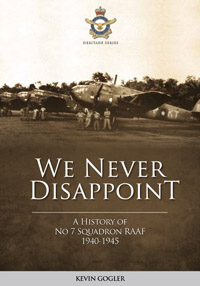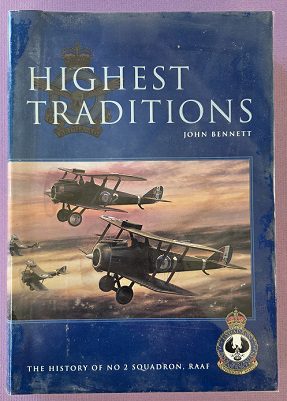Description
Title: We Never Disappoint – A History of 7 Squadron 1940-1945
Author: Gogler, Kevin
Condition: Mint
Edition: 1st Edition
Publication Date: 2012
ISBN: 9781920800680
Cover: Soft Cover without Dust Jacket – 266 pages
Comments: The detailed history of No 7 Squadron, RAAF during World War 2 (1940 to 1945).
We Never Disappoint tells the story of No 7 Squadron, RAAF, and their struggle as the squadron built itself up several times to be ready for operational deployments in the Pacific, only to be let down by aircraft shortages, constant personnel changes and uncertainty over its role in the defence of Australia. When the time for action came, the squadron’s participation included some of the first anti-submarine strikes by Australian Beauforts, search and rescue and reconnaissance missions, and air operations during the Wewak amphibious campaign of May 1945.
We Never Disappoint chronicles the five years of No 7 Squadron’s operations through the recollections and records of the men who were there. Detailed written and oral histories, and RAAF historical records, have been collected to form an informative history of the squadron that includes personal anecdotes and insight into the lives and daily activities of men who gave their all to the cause no matter what the assignment or location. This personal touch establishes We Never Disappoint as a worthy addition alongside other books on the RAAF in the Pacific. It fills a gap in the RAAF’s history, helping to tell the story of Australian Beauforts in action and the crews that flew them.
When 7 Squadron was reformed at Laverton in Victoria on 27 June 1940 it was to be equipped with Hudson aircraft. However, due to supply shortages the unit was without aircraft for 18 months. Its handful of airmen operated with 2 Squadron to gain experience. From April 1942 the now independent 7 Squadron deployed aircraft on coastal patrols, seaward searches, and anti-submarine patrols. An attack on an enemy submarine south-west of Gabo Island on 4 June was the squadron’s first action.
In August the squadron moved to Nowra, where it was re-equipped with Beauforts, and then to the Ross River strip in Townsville. Serving as a bomber–reconnaissance squadron, unit aircraft attacked submarines, conducted patrols and escort duties between the Australian mainland and New Guinea, and dropped supplies to the survivors of the vessel Patcan. For much of 1943 7 Squadron aircraft continued with convoy and reconnaissance duties around the Gulf of Carpentaria and south-west New Guinea.
Bombing raids commenced from Horn Island on 27 November 1943 with an attack on shipping in Kokenau area, Keaukwa village, and the Timoeka airstrip. Early the following year the unit moved to Higgins Field, close to the tip of Cape York Peninsula. Continuing with their patrol duties, several aircraft attacked targets in southern Dutch New Guinea. By the end of October the unit had relocated to Tadji airfield near Aitape, where operations against Japanese positions in Niap and Wewak commenced within the week. Eight aircraft also took part in the rescue of an American bomber crew forced to land at sea just of the Wewak coast on 11 November 1944.
7 Squadron supported the 6th Division as it pushed from Aitape towards Wewak, bombing defensive positions and occupied villages, and patrolling for submarines used to resupply Japanese forces. For two months after the capture of Wewak, aircraft attacked Japanese who had retreated inland, in particular to the desperate battles around Mt Tazaki and Mt Shiborangu.
At the close of hostilities 7 Squadron dropped propaganda and surrender leaflets and undertook travel and courier flights. The unit was officially disbanded on 19 December 1945.
Includes Fatalities, nominal roll, commanding officers, honours and awards, aircraft known to be on strength with No 7 Squadron, aircraft accidents, known aircrews
Includes Nominal Roll




